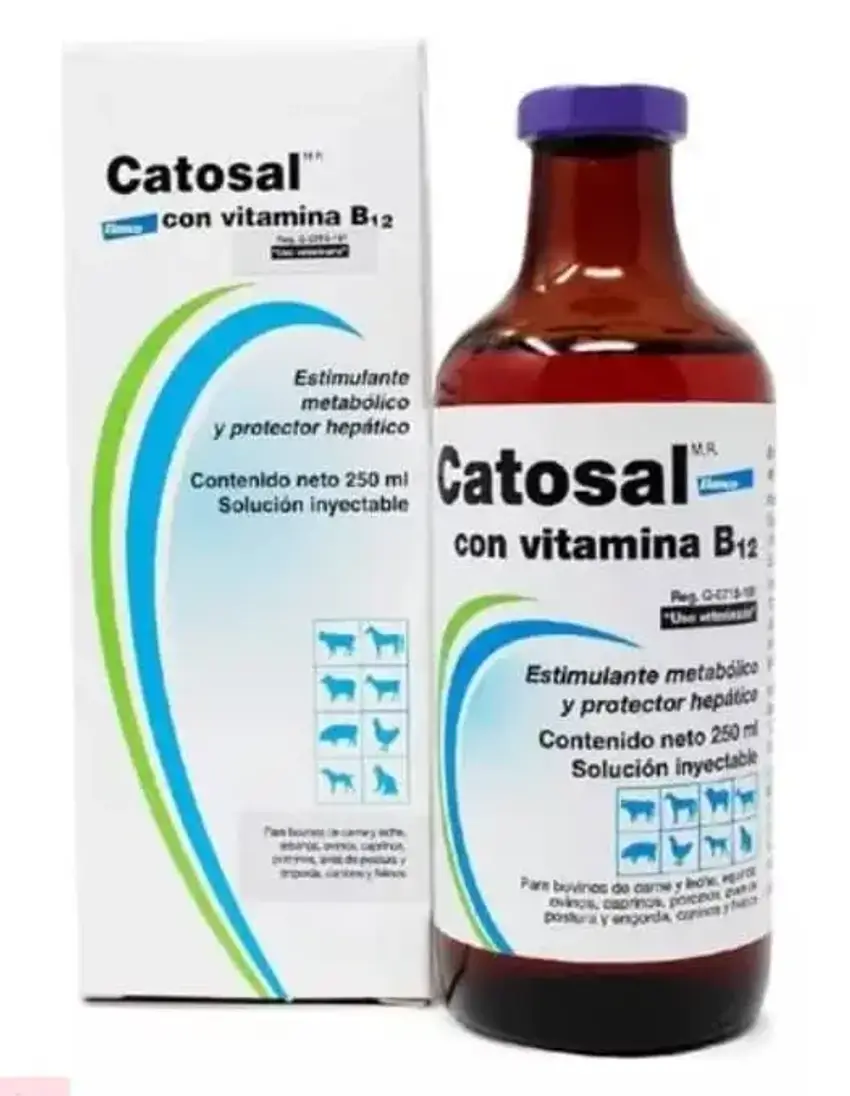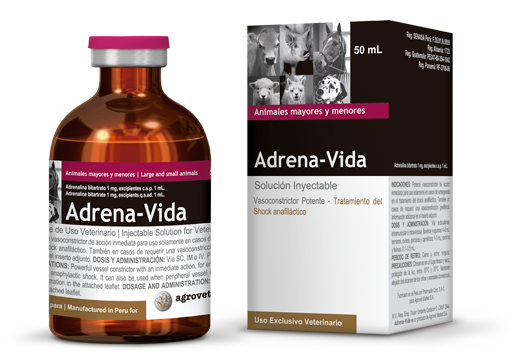Organic phosphorus-based metabolic stimulant. (Injectable.)
Product description:
Phosphorus compounds, as presented in Catosal with vitamin B12, influence almost all the body’s assimilation processes, which is why they have been called metabolic stimulants; They are also involved in a number of enzymatic reactions. Due to its vitamin B12 content, Catosal promotes the metabolism of carbohydrates and lipids, in such a way that it favorably influences body growth, the formation of red blood cells, and also demonstrates a protective action on the liver.
For the exclusive use of the Zootechnical Veterinary Doctor
Formula:
Catosal with vitamin B12 contains:
10% solution of 1-(n-butylamino) 1-methylethylphosphorous acid, which is an organic phosphorus compound, vitamin B12 0.005g/100ml.
Presentation:
Bottles of 20, 50, 100 and 250 ml.
Route of administration:
Catosal with Vitamin B12 can be injected subcutaneously, intramuscularly or intravenously. It can also be mixed with glucose serum or calcium solutions.
Dose:
– Adult horses and bovines ………… 10.0 to 20.0 ml
– Foals and calves………………… 5.0 to 12.0 ml
– Adult sheep and goats ………… 2.5 to 5.0 ml
– Lambs and kids………………. 1.5 to 2.5ml
– Pigs according to their weight ………….. 2.5 to 10.0 ml
– Piglets………………………… 1.0 to 2.5 ml
– Dogs according to their size ………… 0.5 to 5.0 ml
– Cats, fur-bearing animals and chickens. 0.5 to 1.0ml
For healthy animals: Half the dose stated above, and if necessary, repeat it at intervals of 1 to 2 weeks.
Additional information:
In the treatment of chronic diseases, as an adjuvant, it has been shown that combining Catosal with vitamin B12 and strong Vigantol ADE provides great advantages in terms of reducing the recovery period of the treated animals.
Catosal with vitamin B12 is indicated in:
Acute diseases and acute metabolic disorders such as:
– Paresis, loss of appetite, decreased milk yield, acetonemia, etc.
– Exhaustion (for example, after a laborious delivery).
– Vital weakness and diseases of newborns.
– Lumbago of the horse.
– Auxiliary in calcium therapy (for example, in case of tetany or hypocalcemia).
– Poisoning (as an adjuvant).
Chronic diseases and chronic metabolic disorders:
– Developmental disorders of young animals caused by growth diseases.
– States of weakness in small species.
– Cannibalism in birds.
– Bird hysteria.
– Cage fatigue in birds.
General metabolic disorders of domestic animals caused by inadequate feeding:
– Disorders in cattle, during times of drought, before the rains, characterized by the following clinical signs: paresis, lack of appetite, chronic indigestion or rumen overload, malnutrition, decreased milk yield, nervous phenomena, etc.
infertility:
– For the prevention (prophylaxis) of puerperal diseases with the consequent fertility disorders, it is recommended to apply 20 ml, 6 and 4 weeks before delivery, thereby also reducing metabolic problems such as ketosis, milk fever and ovarian cysts.
Anemia:
– Secondary or verminous.
Overwork, fatigue, exhaustion (for example, after a labored delivery):
– To improve muscle performance in racehorses.
– Nutrition disorders, emaciation, exhaustion after illnesses, verminosis, etc.
Treatment of healthy animals:
– To improve the reproductive efficiency of males.
– For dairy cows subjected to the intense effort of lactation.
– To improve the general condition of the animals.
– To prepare animals to participate in exhibitions.
– To increase the performance and resistance of horses for racing, charrería, jumping, dancers, reins, polo, trotting, etc.
| ml | 100 ml, 250 ml |
|---|





